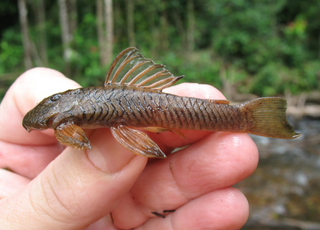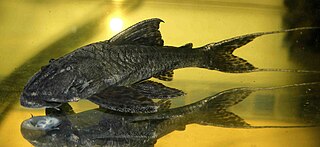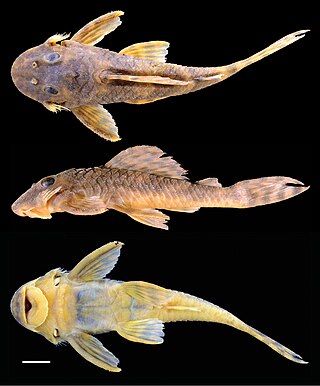
Loricariidae is the largest family of catfish, with 92 genera and just over 680 species. Loricariids originate from freshwater habitats of Costa Rica, Panama, and tropical and subtropical South America. These fish are noted for the bony plates covering their bodies and their suckermouths. Several genera are sold as "plecos", notably the suckermouth catfish, Hypostomus plecostomus, and are popular as aquarium fish.

Hypostomus is a genus of catfish in the family Loricariidae. They are native to tropical and subtropical South America. H. plecostomus is the popular freshwater aquarium fish formerly known as Plecostomus plecostomus. The taxonomic structure of the Loricariidae is still being expanded by scientists. Hypostomus is a highly species-rich and widely distributed catfish genus.

Baryancistrus is a genus of freshwater Loricariid catfish. They inhabit flowing sections of rivers, especially clearwater, in the basins of the Amazon and Orinoco in Brazil and Venezuela. The largest species reach up to 34 cm (13 in) in total length.

Peckoltia is a genus of small South American armored suckermouth catfishes. Many of these fish are popular aquarium fish.
Ancistomus is a genus of suckermouth armored catfishes found in shallow waters in rapidly flowing rivers in the southeastern Amazon basin in Brazil.

Ancistrini is a tribe of catfishes of the family Loricariidae. Most are restricted to tropical and subtropical South America, but there are also several genus in southern Central America.

Pterygoplichthyini is a tribe of catfishes of the family Loricariidae. It includes two genera, Pterygoplichthys and the currently undescribed genus referred to as the Hemiancistrus annectens group, This group was earlier misspelled as Pterygoplichthini. Pterygoplichthyines are known from nearly the entire range of loricariids except for the Guyanas and coastal streams in southeastern Brazil. although later work by the same authority, and his co-authors, placed this group among the genus Hypostomus.
Lithoxus is a genus of suckermouth armored catfishes native to tropical South America.

Guyanancistrus is a genus of suckermouth armored catfishes.
Peckoltia relictum is a species of armored catfish where it is found in the upper Marañon River in northern Peru.

Peckoltia sabaji is a species of catfish in the family Loricariidae. It is native to South America, where it occurs in the basins of the Rupununi, the Essequibo River, and the Takutu River in Guyana, as well as the basins of the Casiquiare canal, the Rio Negro, the Cinaruco River, and the Orinoco in Venezuela. It is usually found among boulders in medium to large rivers. The species reaches 19.8 cm SL and is of disputed classification.

Peckoltia pankimpuju is a species of armored catfish from the family Loricariidae, native to the Marañón River in the upper Amazon basin of Peru. It is commonly called the coal pleco, Peruvian lyre-tail, and L350 under the L-number code. It reaches up to about 40 cm (16 in) in length.

Hemiancistrus subviridis, the green phantom pleco, is a species of armored catfish from the family Loricariidae, commonly found in Venezuela. Within Venezuela, it is native to the Orinoco and Casiquiare drainage basins, where it is usually found among granitic rocks in flowing water. The species reaches 15 cm SL.
Hemiancistrus guahiborum is a species of catfish in the family Loricariidae. It is native to South America, where it occurs in the Orinoco drainage in Venezuela. The species reaches at least 12.55 cm SL and was described in 2005 by David C. Werneke and Jonathan W. Armbruster of Auburn University, Nathan K. Lujan of the American Museum of Natural History, and Donald C. Taphorn of the Royal Ontario Museum on the basis of its distinctive coloration and morphology. It appears in the aquarium trade, where it is usually known either as the orange-seam pleco or by its L-number, which is L-106.

Peckoltia ephippiata is a species of catfish in the family Loricariidae. It is a freshwater fish native to South America, where it is known from the Leitão River, which is part of the Madeira River drainage in the state of Rôndonia in Brazil. The species reaches 10.2 cm SL.

Peckoltia lujani is a species of catfish in the family Loricariidae. It is native to South America, where it occurs in the Orinoco and Meta River basins in Venezuela and Colombia. The species reaches 7.5 cm SL.
'Pseudancistrus' megacephalus is a species of catfish in the family Loricariidae. It is of uncertain and disputed classification.
Ancistomus micrommatos is a species of catfish in the family Loricariidae. It is a freshwater fish native to South America, where it is known only from the Tocantins River basin in Brazil. The species reaches 11.9 cm in standard length. Although originally described as a species of Hemiancistrus in 2003, a 2015 review conducted by Jonathan W. Armbruster, David C. Werneke, and Milton Tan listed the species as valid within Ancistomus. The same review also reported that no characteristics were found to separate A. micrommatos from its congeners A. spilomma and A. spinosissimus, indicating that the three may actually all be the same species.
Ancistomus spilomma is a species of catfish in the family Loricariidae. It is native to South America, where it is known only from the Tocantins River basin in Brazil. The species reaches 14.2 cm in standard length. Although originally described as a species of Hemiancistrus in 2003, a 2015 review conducted by Jonathan W. Armbruster, David C. Werneke, and Milton Tan listed the species as valid within Ancistomus. The same review also reported that no characteristics were found to separate A. spilomma from its congeners A. micrommatos and A. spinosissimus, indicating that the three may actually all be the same species.
Ancistomus spinosissimus is a species of catfish in the family Loricariidae. It is a freshwater fish native to South America, where it is known only from the upper and middle Tocantins River basin in Brazil. The species reaches 12.7 cm in standard length. Although originally described as a species of Hemiancistrus in 2003, a 2015 review conducted by Jonathan W. Armbruster, David C. Werneke, and Milton Tan listed the species as valid within Ancistomus. The same review also reported that no characteristics were found to separate A. spinosissimus from its congeners A. micrommatos and A. spilomma, indicating that the three may actually all be the same species.












